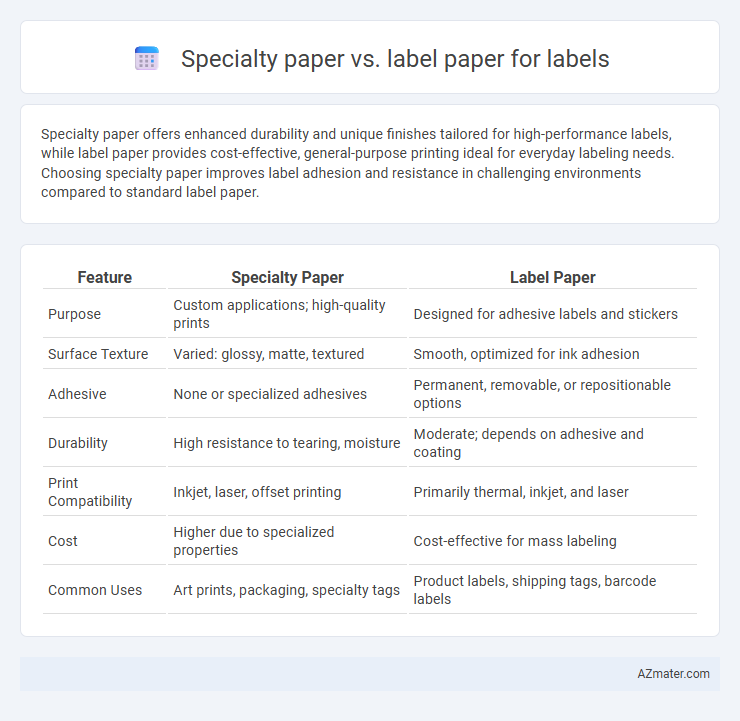Specialty paper offers enhanced durability and unique finishes tailored for high-performance labels, while label paper provides cost-effective, general-purpose printing ideal for everyday labeling needs. Choosing specialty paper improves label adhesion and resistance in challenging environments compared to standard label paper.
Table of Comparison
| Feature | Specialty Paper | Label Paper |
|---|---|---|
| Purpose | Custom applications; high-quality prints | Designed for adhesive labels and stickers |
| Surface Texture | Varied: glossy, matte, textured | Smooth, optimized for ink adhesion |
| Adhesive | None or specialized adhesives | Permanent, removable, or repositionable options |
| Durability | High resistance to tearing, moisture | Moderate; depends on adhesive and coating |
| Print Compatibility | Inkjet, laser, offset printing | Primarily thermal, inkjet, and laser |
| Cost | Higher due to specialized properties | Cost-effective for mass labeling |
| Common Uses | Art prints, packaging, specialty tags | Product labels, shipping tags, barcode labels |
Overview of Specialty Paper and Label Paper
Specialty paper is engineered with unique properties such as high durability, water resistance, and thermal stability, making it ideal for applications requiring enhanced performance beyond standard printing needs. Label paper, specifically designed for adhesive labels, features a pressure-sensitive backing and is optimized for compatibility with label printers to ensure strong adhesion and print clarity. Understanding the different formulations and functional characteristics helps in selecting the appropriate paper type for labeling purposes based on environmental conditions and intended use.
Key Differences Between Specialty and Label Papers
Specialty paper is designed for unique applications requiring enhanced properties like durability, water resistance, or texture, while label paper is specifically engineered for labeling purposes with optimal printability and adhesive compatibility. Specialty papers often include coated, synthetic, or textured variants that improve performance in harsh environments, whereas label papers focus on clarity, tackiness, and ease of application on various surfaces. Key differences hinge on functional attributes such as print quality, adhesive strength, and environmental resistance tailored to either general specialty uses or precise labeling requirements.
Material Composition and Characteristics
Specialty paper for labels often features unique material compositions such as synthetic fibers, textured finishes, or coatings designed to enhance durability, water resistance, and print quality. Label paper typically consists of standard kraft or bond paper with an adhesive backing, optimized for smooth surface printing and easy peeling from the liner. The primary distinction lies in specialty paper's tailored materials for specific environments, whereas label paper prioritizes general adhesion and print clarity for widespread applications.
Printing Compatibility and Performance
Specialty paper offers enhanced printing compatibility with high-resolution inkjet and laser printers, delivering superior image clarity and color vibrancy, which is crucial for premium labels. Label paper, designed specifically for label printers, ensures optimal adhesive performance and durability, making it ideal for applications requiring strong adhesion and resistance to environmental factors. Choosing between specialty and label paper depends on the printer technology and desired label durability, with specialty paper favoring print quality and label paper focusing on functional performance.
Adhesive Options and Adhesion Strength
Specialty paper for labels offers a variety of adhesive options including permanent, removable, and repositionable adhesives designed to suit diverse surfaces and applications. Label paper typically features adhesives optimized for strong initial tack and high adhesion strength on common materials like plastic, glass, and metal. Choosing the right adhesive type directly impacts label durability, ensuring optimal performance in terms of resistance to peeling, moisture, and temperature variations.
Durability and Resistance Features
Specialty paper for labels offers enhanced durability with superior resistance to water, chemicals, and tearing, ensuring long-lasting adhesion in harsh environments. Label paper, while lighter and more cost-effective, typically provides basic tear resistance but lacks the advanced waterproof and solvent-resistant properties of specialty options. Choosing specialty paper improves label longevity on products exposed to moisture and abrasion, critical for industrial and outdoor applications.
Cost Comparison: Specialty vs. Label Paper
Specialty paper for labels generally incurs higher costs due to its enhanced durability, resistance to moisture, and unique finishes tailored for specific labeling needs. Label paper tends to be more cost-effective for standard labeling applications, as it uses basic materials optimized for mass production and quick printing. Comparing costs should consider not only material price but also long-term benefits such as label longevity, adherence quality, and environmental resistance that specialty paper provides.
Application Suitability and Use Cases
Specialty paper offers enhanced durability, moisture resistance, and print quality, making it ideal for high-end product labeling, food packaging, and industrial applications requiring long-lasting adhesion and clear visual appeal. Label paper, typically more cost-effective and designed for general-purpose labeling, suits short-term uses like shipping labels, inventory tags, and barcodes where frequent replacement is expected. Choosing the right paper depends on the specific environment, exposure conditions, and longevity needs of the label application.
Environmental Impact and Sustainability
Specialty paper for labels often uses recycled fibers and eco-friendly coatings, reducing environmental impact through biodegradability and lower carbon emissions compared to conventional label paper. Label paper designed specifically for labeling applications typically incorporates sustainable sourcing practices, such as FSC certification and reduced chemical treatments, to enhance recyclability and minimize landfill waste. Choosing specialty paper over standard label paper supports sustainable manufacturing processes and helps decrease the overall ecological footprint of label production.
Choosing the Right Paper for Your Labeling Needs
Specialty paper offers enhanced durability, resistance to moisture, and specific finishes tailored for unique labeling environments, making it ideal for high-quality, long-lasting labels. Label paper provides cost-effective, easy-to-print surfaces suitable for everyday labeling tasks with standard printers and general applications. Selecting the right paper depends on factors such as label durability requirements, environmental exposure, and printer compatibility to ensure optimal adhesion and appearance.

Infographic: Specialty paper vs Label paper for Label
 azmater.com
azmater.com